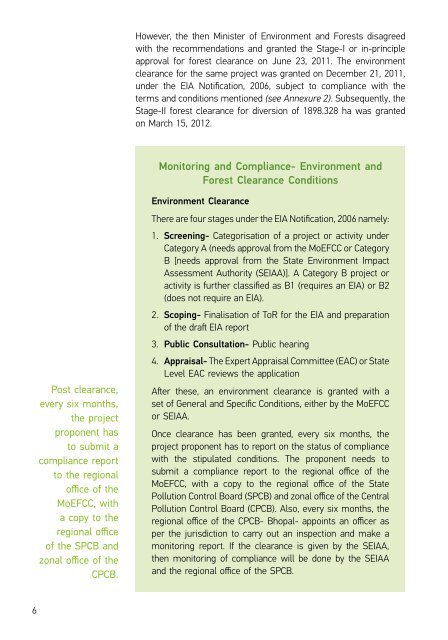ENFORCEMENT GAP
2bl6Lc0
2bl6Lc0
You also want an ePaper? Increase the reach of your titles
YUMPU automatically turns print PDFs into web optimized ePapers that Google loves.
Post clearance,<br />
every six months,<br />
the project<br />
proponent has<br />
to submit a<br />
compliance report<br />
to the regional<br />
office of the<br />
MoEFCC, with<br />
a copy to the<br />
regional office<br />
of the SPCB and<br />
zonal office of the<br />
CPCB.<br />
However, the then Minister of Environment and Forests disagreed<br />
with the recommendations and granted the Stage-I or in-principle<br />
approval for forest clearance on June 23, 2011. The environment<br />
clearance for the same project was granted on December 21, 2011,<br />
under the EIA Notification, 2006, subject to compliance with the<br />
terms and conditions mentioned (see Annexure 2). Subsequently, the<br />
Stage-II forest clearance for diversion of 1898.328 ha was granted<br />
on March 15, 2012.<br />
Monitoring and Compliance- Environment and<br />
Forest Clearance Conditions<br />
Environment Clearance<br />
There are four stages under the EIA Notification, 2006 namely:<br />
1. Screening- Categorisation of a project or activity under<br />
Category A (needs approval from the MoEFCC or Category<br />
B [needs approval from the State Environment Impact<br />
Assessment Authority (SEIAA)]. A Category B project or<br />
activity is further classified as B1 (requires an EIA) or B2<br />
(does not require an EIA).<br />
2. Scoping- Finalisation of ToR for the EIA and preparation<br />
of the draft EIA report<br />
3. Public Consultation- Public hearing<br />
4. Appraisal- The Expert Appraisal Committee (EAC) or State<br />
Level EAC reviews the application<br />
After these, an environment clearance is granted with a<br />
set of General and Specific Conditions, either by the MoEFCC<br />
or SEIAA.<br />
Once clearance has been granted, every six months, the<br />
project proponent has to report on the status of compliance<br />
with the stipulated conditions. The proponent needs to<br />
submit a compliance report to the regional office of the<br />
MoEFCC, with a copy to the regional office of the State<br />
Pollution Control Board (SPCB) and zonal office of the Central<br />
Pollution Control Board (CPCB). Also, every six months, the<br />
regional office of the CPCB- Bhopal- appoints an officer as<br />
per the jurisdiction to carry out an inspection and make a<br />
monitoring report. If the clearance is given by the SEIAA,<br />
then monitoring of compliance will be done by the SEIAA<br />
and the regional office of the SPCB.<br />
Forest Clearance- Diversion of Forest Land<br />
for Non-Forest Use<br />
Whenever a government department or private agency or<br />
an individual wants to use forest land for non-forest use,<br />
permission has to be taken for the diversion of forest land<br />
from the relevant forest department and from the Divisional<br />
Forest Officer (DFO) in particular. Based on the application, the<br />
DFO will inspect the site and prepare a report against a series<br />
of criteria. She/he will then forward a recommendation on<br />
whether or not the forest land can be diverted for non-forest<br />
use. While the DFO prepares the site inspection report, the<br />
District Collector (DC) certifies that the recognition of rights<br />
as per the Forest Rights Act (FRA), 2006 has been completed<br />
in the area. If this has not taken place, she/he needs to<br />
ensure that the FRA claims are settled and thereafter take<br />
the consent of the gram sabha for diversion of the forest land.<br />
Next, based on the DFO’s recommendation, the Principal Chief<br />
Conservator of Forests (PCCF) will forward the proposal. If the<br />
area in question is more than 40 ha, then this will be to the<br />
MoEFCC’s FAC. The FAC will then review the proposal, and if<br />
required undertake a site visit as well during the process of<br />
review. It will give its recommendations, based on which the<br />
MoEFCC grants the Stage-I clearance or in-principle approval<br />
with a set of conditions for compliance.<br />
If the area is less than 40 ha, the proposal will be forwarded<br />
to the relevant regional office of the MoEFCC. Then, based on<br />
the recommendation of the Regional Empowered Committee<br />
(REC), the Additional PCCF (APCCF) will decide whether or not<br />
to grant the forest clearance.<br />
To monitor compliance with the conditions given in the<br />
Stage-I clearance, the project authority has to submit a<br />
compliance report every six months to the regional office<br />
of the MoEFCC at Bhopal and also to the DFO at the regional<br />
office of the State Forest Department. Additionally, according<br />
to the jurisdiction, an officer from regional office of the<br />
MoEFCC will visit the site for an inspection every six months<br />
and document compliance with the conditions. Based on<br />
compliance with conditions in the Stage-I clearance, the FAC,<br />
if satisfied, grants the Stage-II clearance. The final notification<br />
is to be given by the state under section 2 of the Forest<br />
Conservation Act, 1980.<br />
6 7


